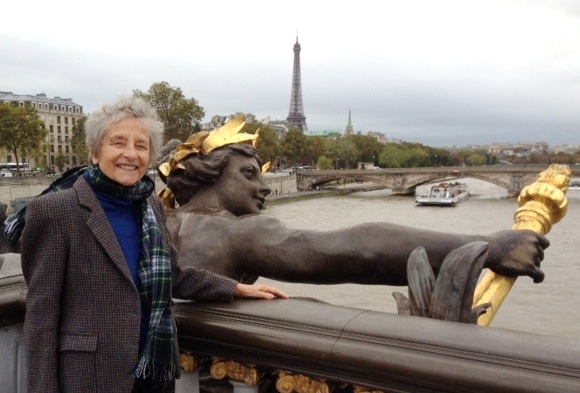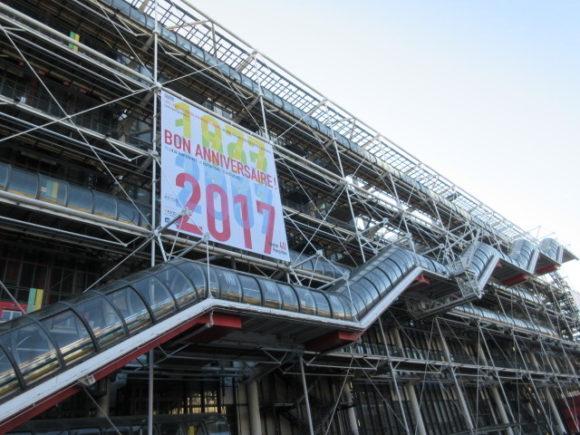
The Musée National d’Art Moderne (MNAM), better known as the Centre Pompidou – that crazy structure with tubes, exhaust pipes, chimneys and metal rods in bright primary colors – is celebrating 40 years of existence. Its revolutionary architecture oriented toward multidisciplinary activities, which turned it into what virulent opponents called a “supermarket for the arts,” scandalized visitors at first, but is now the benchmark for art museums around the word.
In 1969, President Georges Pompidou and his wife Claude, wanted to create an institution accessible to everyone, innovative enough to arouse the curiosity and the interest of the general public. He wrote in Le Monde on Oct. 17, 1972, “It is my passionate wish for Paris to have a cultural center like the ones they have created in the United States, which have thus far been an unequalled success. It would be one that is both a museum and a center of creation where the visual arts take residence with music, films, books, audiovisual research, etc.”
The project was conceived soon after the May 1968 student contest, which shook French society to the core. A location was found in a vacant parking lot in the dilapidated working class district of Beaubourg. Construction lasted five years from 1972 to 1977.
Young architects – Italian Renzo Piano and Englishman Richard Rogers along with Italian Gianfranco Franchini – won the international competition and designed a project breaking away from the tradition of solemn museums. Their innovative design consisted of a metal structure with six levels of flexible and open-plan floors.

The anchor of the assemblage was a giant pillar supporting a network of metal beams and interlocking parts. The external escalator, enclosed in glass, zigzags its way up to the roof-top like a caterpillar (hence its nickname) along the face of the building. The color-coded functional pipes – blue for the air, yellow for electricity, green for water and red for circulation – give a playful appearance to the construction.
The idea was to integrate the museum within its urban environment. The facade is all glass and there is no threshold between the outdoors and the Forum or heart of the center. Whenever the exhibits are too large to be set up inside – as was the case with the 1979 Dali retrospective, which attracted 800,000 visitors – they spill over the gently sloping piazza or the nearby Stravinsky Fountain.
President Valery Giscard d’Estaing inaugurated the building on Jan. 31, 1977 with high officials and celebrities in attendance. Adding to the pageantry , the Garde Republicaine arrived on horseback , holding Andy Warhol-creation-like banners. Forty eight hours later, the Centre Pompidou opened to the general public.
The 40,000 visitors could not hold their excitement as they rode the escalator to the upper terraces, well above the roofs of Paris. The organizers were afraid the building would collapse with the unexpected size of the crowds. Looking at the metal structure, someone supposedly commented, “Why didn’t they take down the scaffolding?”
The permanent collections of modern art, spanning the period from 1905 until the 1960s, are on the fifth floor. The plan layout allows for the easy flow of visitors between rooms of all sizes. The walls are stark white. A wide hallway leads to huge windows opening on a reflecting pool and a free-standing, 25 ft. high mobile by Alexander Calder. Montmartre is in the background .
The art lover will see just a sampling or five per cent of the phenomenal collections owned by the museum, which includes works by Sonia and Robert Delauney, Fernand Leger, Mondrian, Matisse, Picasso, Yves Klein, Juan Gris, Goncharova, Larionov and many others. One room is dedicated to Marcel Duchamp and includes the famous bicycle on a kitchen stool (MOMA has another copy), and the hard-to-understand Neuf Moules Mâlic, (generally translated as Nine Malic Moulds) 1914, which was a preparation for la Mariée mise à nu par ses celibataires (the bride stripped naked by her nine bachelors).
Contemporary art, starting in the latter part of the 20th century, is displayed on the fifth floor. At present an exhibit entitled “Kollektsia” includes 250 works from the USSR and the new Russia from 1950-2000, donated by the Vladimir Potanin Foundation. Fascinating videos bring back the world of the 1960s in the Soviet era.
One video shows Nikita Khrushchev in a heated discussion about modern art with the public at the Manege. Another video shows the government’s bulldozers destroying the open-air exhibit hurriedly organized by the dissident Russian painters.
The Centre Pompidou, as an institution offering cultural activities at all levels, includes two special departments. One is IRCAM (Institute for Research and Coordination of Acoustics and Music.) Founded by composer Pierre Boulez, it is a research center, using advanced technology working on ways to visualize music. On the other hand, the Public Information Library or BPI is an enormous facility with resources in a multiplicity of media. It is open to all and offers wonderfully convenient free access to its shelves.
The production of the Centre Pompidou, during the past 40 years, has included major retrospectives establishing links between artistic capitals such as “Paris-Moscow” or “Paris-New York,” hundreds of monograph exhibits or surprising sights such as the grand piano of German artist Beuys made of felt hanging from the ceiling.
The $64,000 question is, will the Centre Pompidou be able to sustain this feverish pace or will it ultimately run out of steam? There is no question that the curators are fully committed to ensuring that this latter scenario does not happen.
Editor’s Note: This is the opinion of Nicole Prévost Logan.
 About the author: Nicole Prévost Logan divides her time between Essex and Paris, spending summers in the former and winters in the latter. She writes a regular column for us from her Paris home where her topics will include politics, economy, social unrest — mostly in France — but also in other European countries. She also covers a variety of art exhibits and the performing arts in Europe. Logan is the author of ‘Forever on the Road: A Franco-American Family’s Thirty Years in the Foreign Service,’ an autobiography of her life as the wife of an overseas diplomat, who lived in 10 foreign countries on three continents. Her experiences during her foreign service life included being in Lebanon when civil war erupted, excavating a medieval city in Moscow and spending a week under house arrest in Guinea.
About the author: Nicole Prévost Logan divides her time between Essex and Paris, spending summers in the former and winters in the latter. She writes a regular column for us from her Paris home where her topics will include politics, economy, social unrest — mostly in France — but also in other European countries. She also covers a variety of art exhibits and the performing arts in Europe. Logan is the author of ‘Forever on the Road: A Franco-American Family’s Thirty Years in the Foreign Service,’ an autobiography of her life as the wife of an overseas diplomat, who lived in 10 foreign countries on three continents. Her experiences during her foreign service life included being in Lebanon when civil war erupted, excavating a medieval city in Moscow and spending a week under house arrest in Guinea.